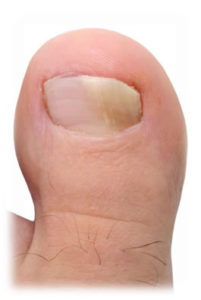Fungal nail infections
Finger and toenail infections can be difficult and time consuming to treat effectively. More commonly seen in males, the elderly, diabetics or smokers, fungal nail infections can be unsightly and painful. Fungal nail conditions need to be differentiated from other dermatological pathologies and a sample of the nail may be removed for histological evaluation.
 Treatments may include:
Treatments may include:
- Nail filing
- Topical or lacquer-based antifungal applications
- Oral anti-fungal medication.
- Partial removal of the effected nail.
- Complete removal of the nail – this is is rare and reserved for cases of recurrent or painful infection.
In most cases of toe nail infection it is vital that the surface of the nail be carefully and thoroughly filed. Filing is always carried out under local anaesthesia and should be pain free.
During your treatment, local anaesthetic will be injected around the toe or finger so the nail can be file using an electric podiatric nail file. Ice may be applied to the finger or toe prior to a local anaesthetic injection to reduce the discomfort of the anesthesia.
Once the nail has been filed, regular application of a topical antifungal agent is essential until the nail has fully regrown. This can take anywhere from 3 to 12 months. During this period you will be unable to apply topical nail polish as this will prevent the effective application of the anti-fungal agent.
You can prevent fungal nail infections by ensuring that your nails are kept short and are cleaned and dried thoroughly each day (including between the toes). Do not apply nail polish to nails you suspect may have an infection. Footwear that help your feet and toes remain dry (such as thongs or open-toed sandals) can prevent infection. Such footwear will NOT serve to treat infection once present.
For a full list of our fees and services click here.
To make an online booking with one of our doctors click here.





